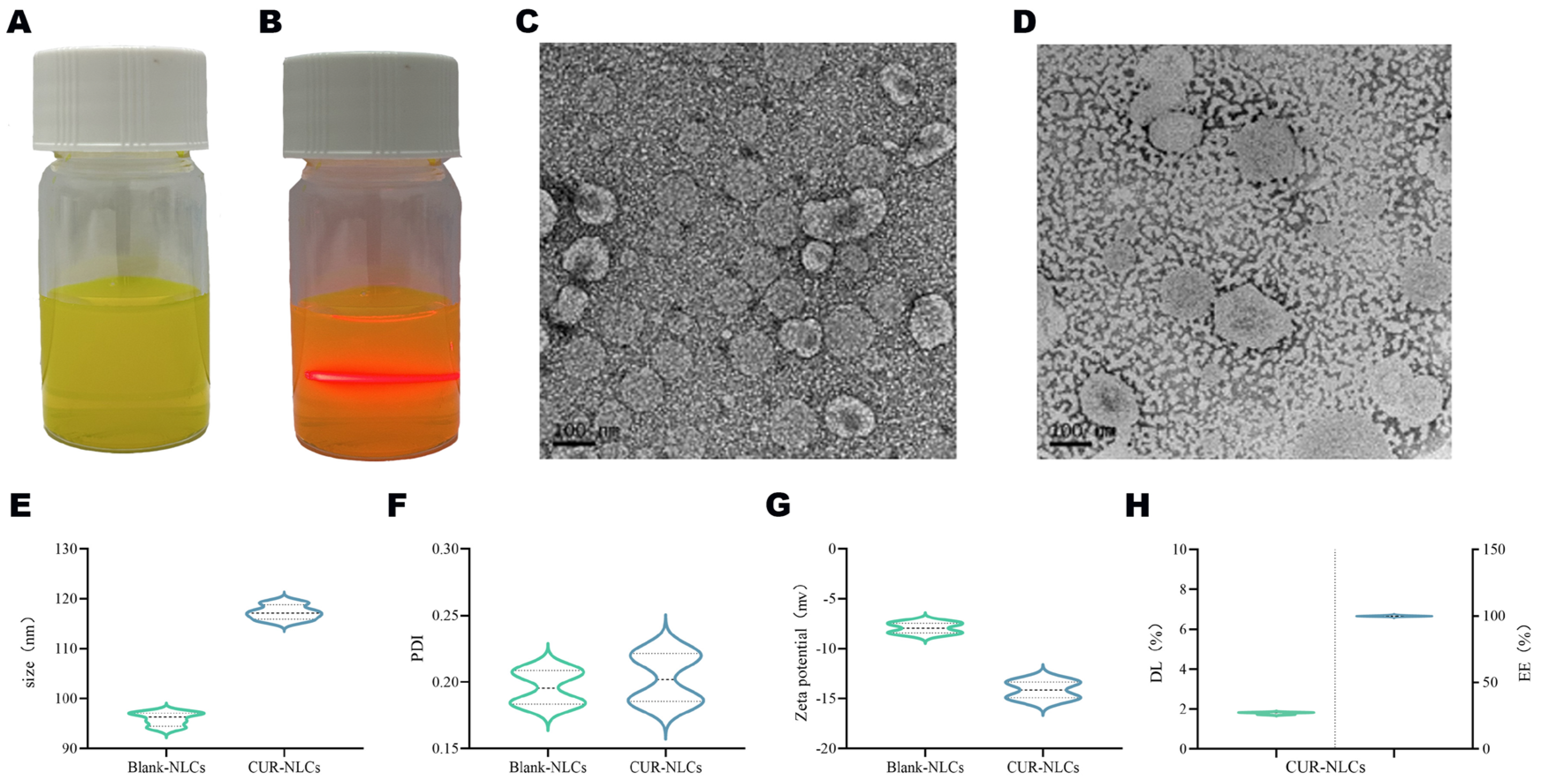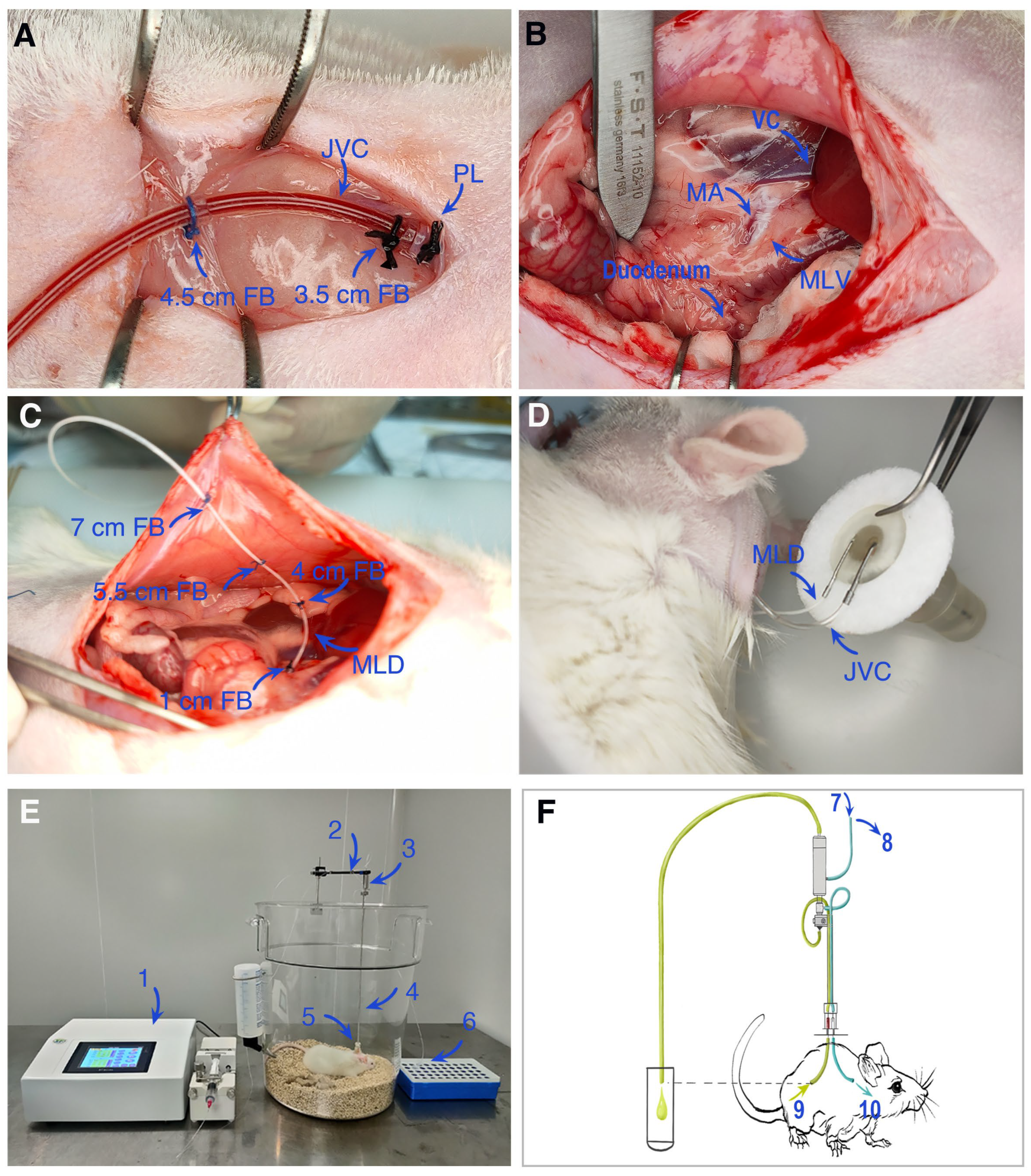Lymph-Targeted Delivery of CUR-NLCs Enhances Oral Bioavailability: Evidence from a Double-Catheterized Rat Model
Abstract
1. Introduction
2. Materials and Methods
2.1. Materials
2.1.1. Chemical and Major Instruments
2.1.2. Liquid Chromatography-Tandem Mass Spectrometry (LC-MS/MS) Conditions
2.1.3. Animals
2.2. Preparation of CUR-NLCs
2.3. Physicochemical Characterization of CUR-NLCs
2.3.1. Particle Size and Zeta Potential Measurement
2.3.2. Encapsulation Efficiency (EE) and Drug Loading (DL)
2.3.3. Transmission Electron Microscope (TEM) Morphological Observation
2.4. Detection of CUR-NLCs Stability
2.4.1. Storage Stability
2.4.2. CUR-NLCs Gastrointestinal Stability
2.4.3. CUR-NLCs Release
2.5. Lymphatic Transport and Pharmacokinetic Analysis of CUR-NLCs
2.5.1. Establishment of an Auxiliary Mesenteric Lymph-Jugular Venous Reflux Model in SD Rats
2.5.2. Pharmacokinetic Analysis in Serum and Lymph
2.5.3. TEM Observation of Intestinal Segments
2.6. Statistical Analysis
3. Results
3.1. Characterization of CUR-NLCs
3.2. Stability and In Vitro Release Behavior of CUR-NLCs
3.3. Lymphatic Transport and Pharmacokinetic Evaluation of CUR-NLCs
4. Discussion
5. Conclusions
Author Contributions
Funding
Institutional Review Board Statement
Informed Consent Statement
Data Availability Statement
Acknowledgments
Conflicts of Interest
Abbreviations
| CUR | Curcumin |
| CUR-NLCs | Curcumin-loaded nanostructured lipid carrier |
| CUR-Sol | Curcumin Solution |
| LC-MS/MS | Liquid Chromatography-Tandem Mass Spectrometry |
| SPF | Specific Pathogen Free |
| SD | Sprague Dawley |
| DLS | dynamic light scattering |
| EE | Encapsulation Efficiency |
| DL | Drug Loading |
| SGF | Simulated Gastric Fluid |
| SIF | Simulated Intestinal Fluid |
| VAB | Vascular Access Button |
| FB | fixation buckle |
| JVC | jugular vein catheter |
| PL | proximal ligation |
| VC | vena cava |
| MA | mesenteric artery |
| JV | jugular vein |
| CO2 | carbon dioxide |
References
- Giordano, A.; Tommonaro, G. Curcumin and Cancer. Nutrients 2019, 11, 2376. [Google Scholar] [CrossRef]
- Lin, X.; Wei, Z. Curcumin attenuates oxidative stress in RAW264.7 cells by increasing the activity of antioxidant enzymes and activating the Nrf2-Keap1 pathway. PLoS ONE 2019, 14, e0216711. [Google Scholar] [CrossRef]
- Peng, Y.; Ao, M. Anti-Inflammatory Effects of Curcumin in the Inflammatory Diseases: Status, Limitations and Countermeasures. Drug Des. Dev. Ther. 2021, 15, 4503–4525. [Google Scholar] [CrossRef] [PubMed]
- Zhou, Y.; Gong, J. Curcumin and nanodelivery systems: New directions for targeted therapy and diagnosis of breast cancer. Biomed. Pharmacother. 2024, 180, 117404. [Google Scholar] [CrossRef] [PubMed]
- Chowdhury, R.; Nimmanapalli, R. Curcumin attenuation of lipopolysaccharide induced cardiac hypertrophy in rodents. ISRN Inflamm. 2013, 2013, 539305. [Google Scholar] [CrossRef] [PubMed]
- Lao, C.D.; Ruffin, M.T. Dose escalation of a curcuminoid formulation. BMC Complement. Altern. Med. 2006, 6, 10. [Google Scholar] [CrossRef]
- Anand, P.; Kunnumakkara, A.B. Bioavailability of curcumin: Problems and promises. Mol. Pharm. 2007, 4, 807–818. [Google Scholar] [CrossRef]
- Plaza-Oliver, M.; Santander-Ortega, M.J. Current approaches in lipid-based nanocarriers for oral drug delivery. Drug Deliv. Transl. Res. 2021, 11, 471–497. [Google Scholar] [CrossRef]
- Yáñez, J.A.; Wang, S.W. Intestinal lymphatic transport for drug delivery. Adv. Drug Deliv. Rev. 2011, 63, 923–942. [Google Scholar] [CrossRef] [PubMed]
- Sheng, L.; Wei, Y.; Pi, C. Preparation and Evaluation of Curcumin Derivatives Nanoemulsion Based on Turmeric Extract and Its Antidepressant Effect. Int. J. Nanomed. 2023, 18, 7965–7983. [Google Scholar] [CrossRef]
- Ma, C.Y.; Chiang, Y.C. Effect of Pre-Heating on Enhancing the Anti-Digestive and Antioxidant Properties of Curcumin Rice by Self-Emulsifying Technology. Foods 2025, 14, 3668. [Google Scholar] [CrossRef] [PubMed]
- Elkhateeb, O.; Badawy, M.E.I. Curcumin-infused nanostructured lipid carriers: A promising strategy for enhancing skin regeneration and combating microbial infection. BMC Vet. Res. 2023, 19, 206. [Google Scholar] [CrossRef] [PubMed]
- Müller, R.H.; Radtke, M. Solid lipid nanoparticles (SLN) and nanostructured lipid carriers (NLC) in cosmetic and dermatological preparations. Adv. Drug Deliv. Rev. 2002, 54 (Suppl. 1), S131–S155. [Google Scholar] [CrossRef]
- Pathak, K.; Keshri, L. Lipid nanocarriers: Influence of lipids on product development and pharmacokinetics. Crit. Rev. Ther. Drug Carr. Syst. 2011, 28, 357–393. [Google Scholar] [CrossRef]
- Gaba, B.; Fazil, M. Nanostructured lipid (NLCs) carriers as a bioavailability enhancement tool for oral administration. Drug Deliv. 2015, 22, 691–700. [Google Scholar] [CrossRef]
- Tian, C.; Asghar, S. Improving intestinal absorption and oral bioavailability of curcumin via taurocholic acid-modified nanostructured lipid carriers. Int. J. Nanomed. 2017, 12, 7897–7911. [Google Scholar] [CrossRef]
- Dolatabadi, S.; Karimi, M. Preparation, characterization and in vivo pharmacokinetic evaluation of curcuminoids-loaded solid lipid nanoparticles (SLNs) and nanostructured lipid carriers (NLCs). J. Drug Deliv. Sci. Technol. 2021, 62, 102352. [Google Scholar] [CrossRef]
- Baek, J.S.; Cho, C.W. Surface modification of solid lipid nanoparticles for oral delivery of curcumin: Improvement of bioavailability through enhanced cellular uptake, and lymphatic uptake. Eur. J. Pharm. Biopharm. Off. J. Arbeitsgemeinschaft Fur Pharm. Verfahrenstechnik e.V 2017, 117, 132–140. [Google Scholar] [CrossRef]
- Wang, J.; Ma, W.; Tu, P. The mechanism of self-assembled mixed micelles in improving curcumin oral absorption: In vitro and in vivo. Colloids Surf. B Biointerfaces 2015, 133, 108–119, Correction in Colloids Surf. B Biointerfaces 2024, 239, 113935. [Google Scholar] [CrossRef]
- Roger, E.; Lagarce, F. The gastrointestinal stability of lipid nanocapsules. Int. J. Pharm. 2009, 379, 260–265. [Google Scholar] [CrossRef] [PubMed]
- Dandekar, P.; Dhumal, R. Toxicological evaluation of pH-sensitive nanoparticles of curcumin: Acute, sub-acute and genotoxicity studies. Food Chem. Toxicol. Int. J. Publ. Br. Ind. Biol. Res. Assoc. 2010, 48, 2073–2089. [Google Scholar] [CrossRef]
- Nakajima, K.; Tokita, Y. The VLDL receptor plays a key role in the metabolism of postprandial remnant lipoproteins. Clin. Chim. Acta; Int. J. Clin. Chem. 2019, 495, 382–393. [Google Scholar] [CrossRef] [PubMed]
- Su, Z.; Niu, J. Effect of octreotide-polyethylene glycol (100) monostearate modification on the pharmacokinetics and cellular uptake of nanostructured lipid carrier loaded with hydroxycamptothecine. Mol. Pharm. 2011, 8, 1641–1651. [Google Scholar] [CrossRef]
- Xiaorui, Z.; Cao, J. A preliminary method for continuous drainage of mesenteric lymph fluid in rat. Lab. Anim. Comp. Med. 2022, 42, 267–274. (In Chinese) [Google Scholar]
- Desai, M.P.; Labhasetwar, V. Gastrointestinal uptake of biodegradable microparticles: Effect of particle size. Pharm. Res. 1996, 13, 1838–1845. [Google Scholar] [CrossRef]
- Abdullah; Guo, Y.; Song, Z.; Cao, Y.; Xiao, J. Impact of cocoa butter and medium chain triglycerides ratios on processing stability, supersaturation, and digestive properties of curcumin-loaded nanostructured lipid carriers. LWT 2024, 197, 115895. [Google Scholar] [CrossRef]
- Raj, N.; Suman, S. Curcumin encapsulation via protein-stabilized emulsions: Comparative formulation and characterization using whey, soy, and pea proteins. Sustain. Food Technol. 2025; advance online publication. [Google Scholar] [CrossRef]
- Lee, H.; Zhong, Q. Encapsulation of curcumin in casein-dextran sulfate nanocomplexes for enhanced acid stability and bioaccessibility. J. Food Eng. 2025, 393, 112512. [Google Scholar] [CrossRef]
- Ejazi, S.A.; Louisthelmy, R. Mechanisms of Nanoparticle Transport across Intestinal Tissue: An Oral Delivery Perspective. ACS Nano 2023, 17, 13044–13061. [Google Scholar] [CrossRef]
- Gudyka, J.; Ceja-Vega, J. Concentration-Dependent Effects of Curcumin on Membrane Permeability and Structure. ACS Pharmacol. Transl. Sci. 2024, 7, 1546–1556. [Google Scholar] [CrossRef]
- Nugroho, A.; Bo, Z. Optimization and stability analysis of TiO2-palm olein nano-biolubricants using one-factor-at-a-time. J. Mol. Liq. 2025, 438 Pt B, 128525. [Google Scholar] [CrossRef]
- Zandanel, C.; Ponchel, G. Nanoparticles facing the gut barrier: Retention or mucosal absorption? Mechanisms and dependency to nanoparticle characteristics. Int. J. Pharm. 2021, 609, 121147. [Google Scholar] [CrossRef] [PubMed]
- Morozova, A.S.; Vilchevskaya, E.N. A holistic continuum model-based approach to drug release. Contin. Mech. Thermodyn. 2022, 34, 81–91. [Google Scholar] [CrossRef]
- Des Rieux, A.; Fievez, V. Nanoparticles as potential oral delivery systems of proteins and vaccines: A mechanistic approach. J. Control. Release: Off. J. Control. Release Soc. 2006, 116, 1–27. [Google Scholar] [CrossRef] [PubMed]
- Hadinoto, K.; Sundaresan, A. Lipid-polymer hybrid nanoparticles as a new generation therapeutic delivery platform: A review. Eur. J. Pharm. Biopharm. Off. J. Arbeitsgemeinschaft Fur Pharm. Verfahrenstechnik e.V 2013, 85 Pt A, 427–443. [Google Scholar] [CrossRef]
- Wang, K.X.; Cai, M.R. IRMOF-8-encapsulated curcumin as a biocompatible, sustained-release nano-preparation. Appl. Organomet. Chem. 2022, 36, e6680. [Google Scholar] [CrossRef]
- Cheng, C.; Wu, Z.; McClements, D.J. Improvement on stability, loading capacity and sustained release of rhamnolipids modified curcumin liposomes. Colloids Surf. B Biointerfaces 2019, 183, 110460. [Google Scholar] [CrossRef]
- Xiao, C.; Stahel, P. Regulation of Chylomicron Secretion: Focus on Post-Assembly Mechanisms. Cell. Mol. Gastroenterol. Hepatol. 2019, 7, 487–501. [Google Scholar] [CrossRef]





| Formulation | Size (nm) | PDI | Zeta (mV) | DL (%) | EE (%) |
|---|---|---|---|---|---|
| Blank-NLCs | 95.94 ± 1.22 | 0.20 ± 0.01 | −7.93 ± 0.33 | ||
| CUR-NLCs | 117.28 ± 1.32 | 0.20 ± 0.02 | −14.14 ± 0.30 | 1.73 | 99.99 |
| Parameters | CUR-Sol | CUR-NLCs |
|---|---|---|
| Cmax (ng/mL) | 2.33 ± 0.50 | 12.23 ± 3.07 **** |
| Tmax (h) | 0.083 | 0.083 |
| T1/2 (h) | 15.0 ± 2.94 | 33.49 ± 6.90 *** |
| AUC0–t (ng·h/mL) | 1.52 ± 0.59 | 7.81 ± 2.20 **** |
| AUC0–∞ (ng·h/mL) | 1.83 ± 0.70 | 14.5 ± 5.20 **** |
| Parameters | Liquid Collection Time, h | CUR-Sol | CUR-NLCs |
|---|---|---|---|
| Concentrate, ng·mL−1 | 0–4 | 0 | 5.05 ± 0.24 |
| 4–8 | 0 | 0.41 ± 0.03 | |
| 8–24 | 0 | 0.23 ± 0.04 | |
| V, mL | 0–4 | 4.78 ± 0.54 | 4.64 ± 0.33 |
| 4–8 | 4.99 ± 0.48 | 4.48 ± 0.71 | |
| 8–24 | 16.71 ± 0.86 | 16.60 ± 0.66 | |
| Dose percentage, % | 0–4 | 0 | 0.0013 ± 0.0001 |
| 4–8 | 0 | 0.0014 ± 0.0001 | |
| 8–24 | 0 | 0.0016 ± 0.0001 |
Disclaimer/Publisher’s Note: The statements, opinions and data contained in all publications are solely those of the individual author(s) and contributor(s) and not of MDPI and/or the editor(s). MDPI and/or the editor(s) disclaim responsibility for any injury to people or property resulting from any ideas, methods, instructions or products referred to in the content. |
© 2025 by the authors. Licensee MDPI, Basel, Switzerland. This article is an open access article distributed under the terms and conditions of the Creative Commons Attribution (CC BY) license (https://creativecommons.org/licenses/by/4.0/).
Share and Cite
Chi, H.; Zhang, X.; Chen, Z.; Chen, Q.; Yang, B.; Deng, H.; Yu, D. Lymph-Targeted Delivery of CUR-NLCs Enhances Oral Bioavailability: Evidence from a Double-Catheterized Rat Model. Pharmaceutics 2025, 17, 1484. https://doi.org/10.3390/pharmaceutics17111484
Chi H, Zhang X, Chen Z, Chen Q, Yang B, Deng H, Yu D. Lymph-Targeted Delivery of CUR-NLCs Enhances Oral Bioavailability: Evidence from a Double-Catheterized Rat Model. Pharmaceutics. 2025; 17(11):1484. https://doi.org/10.3390/pharmaceutics17111484
Chicago/Turabian StyleChi, Haoming, Xiaorui Zhang, Zhiyuan Chen, Qiuyong Chen, Bo Yang, Hui Deng, and Daojin Yu. 2025. "Lymph-Targeted Delivery of CUR-NLCs Enhances Oral Bioavailability: Evidence from a Double-Catheterized Rat Model" Pharmaceutics 17, no. 11: 1484. https://doi.org/10.3390/pharmaceutics17111484
APA StyleChi, H., Zhang, X., Chen, Z., Chen, Q., Yang, B., Deng, H., & Yu, D. (2025). Lymph-Targeted Delivery of CUR-NLCs Enhances Oral Bioavailability: Evidence from a Double-Catheterized Rat Model. Pharmaceutics, 17(11), 1484. https://doi.org/10.3390/pharmaceutics17111484






